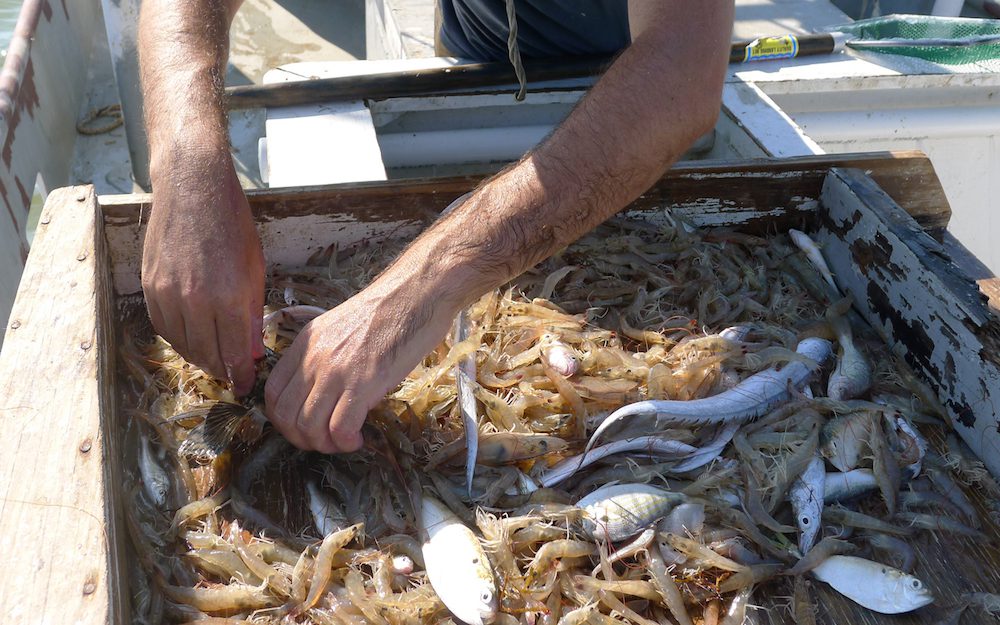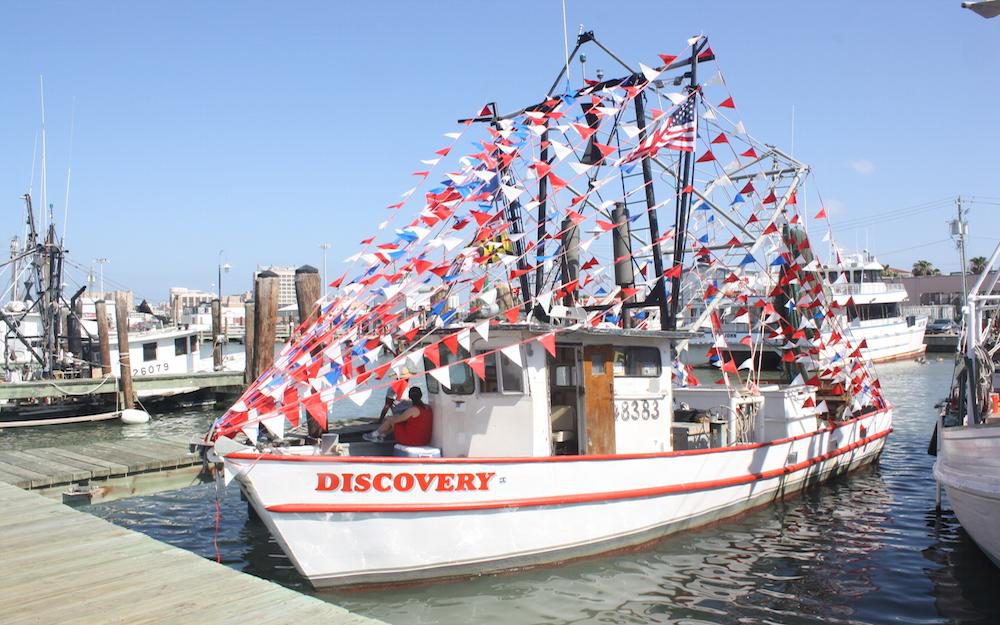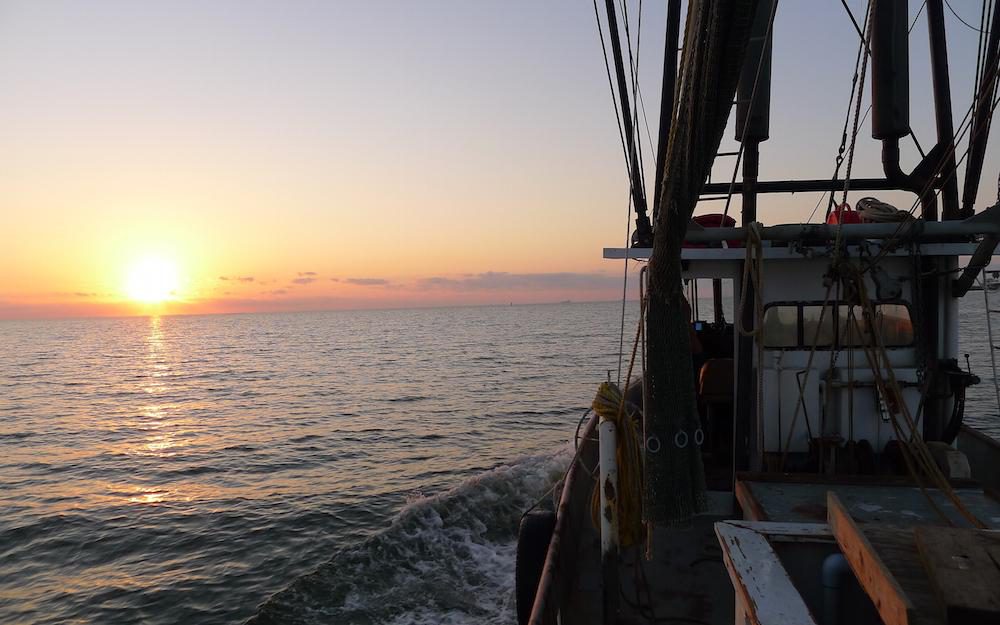On the Water: Shrimp Boat Projects
Nathan C. Martin travels to Texas to speak with artist Zachary Moser, co-founder of Shrimp Boat Projects, about learning from a landscape and knowing when it is time to change course.

Photo by Zachary Moser.
Editor's Note
This essay was originally published in February 2015, but we’re revisiting it as part of our thematic series in conjunction with Erin Johnson’s “Of Moving and Being Moved” at Pelican Bomb Gallery X. To further explore ideas central to the exhibition, we’re publishing new reviews, personal essays, interviews, and digital artist projects exploring the many different ways we live with water. We also want to use this opportunity to highlight previously published pieces from our archives, which have documented our ongoing conversations on water.
I caught Zach Moser at a bit of an awkward moment. He wasn’t able to go shrimping the weekend in October I was passing through Galveston because the shrimp in the bay had gotten too small—as they tend to do at that time of the season—and the nets he had were too loosely woven. The shrimp passed right through them—or “blew out,” as shrimpers would say. When I finally found him after driving south through Houston, getting lost several times in the daunting concrete sprawl, he was on top of another fisherman’s boat buying a new, more finely woven net. As Moser and I spoke, he sat cutting a length of chain from the mass of twine.
But the moment was awkward on a grander scale—not in the magnitude of awkwardness, but in the larger context of the ambitious years-long conceptual art project in which he’s embroiled. It’s not the bad kind of awkward, really—more the curious kind, where you’re watching a situation that’s taken an unexpected turn, and everyone’s standing there, looking at each other, wondering what’s going to happen next.
Moser, a Houston native, is co-founder of Shrimp Boat Projects, for which he and collaborator Eric Leshinsky used a $50,000 Creative Capital grant in 2011 to buy and rehab a shrimp boat. They meant to engage in a three-year exploration by which they would become professional shrimpers and expose themselves, other artists, and the public to an artistic process that uses shrimping to investigate the intersection of labor, landscape, and culture specific to the Houston region.
But four years later, Leshinsky has moved on, and Moser is still shrimping. He’s been making his entire living off it. He said he hadn’t been thinking that much about art.
“There was never an original intent to become a shrimper,” he said. “It was more about what the labor meant in terms of how you identified with the landscape. We were doing the residency and other programs when we first started, but then it very quickly veered into: It doesn’t mean anything if we can’t catch shrimp. And that’s where it sort of fell off.”
The residency to which Moser refers consisted of bringing artists, writers, and other creative types out into the bay to help catch shrimp with the hope that the experience would reveal to residents knowledge intrinsic to the work. The notion segued from one of Moser’s previous projects, Workshop Houston, a hands-on afterschool bike repair program for middle-school students that his wife still runs. The point, Moser said, is pedagogical—learning how to fix a bike teaches kids to learn on their own, an expansive experience that trains them in new methods of thinking and doing that they can apply to other pursuits. If artists learned how to catch shrimp, then, Moser hoped, it could imbue them with the skills and perspective to make work about the region that’s more meaningful and accurate as it relates to the landscape.
“The labor of shrimping has some knowledge that’s only accessible via the action,” he said. “But that, I think, probably has been the biggest failure, mainly because you can’t get that in a short period of time.”
It’s unsurprising in hindsight, Moser said, that a single day on a shrimp boat didn’t yield much to visiting artists in terms of new process-based knowledge. He said one of the reasons he’s kept on shrimping, setting the project’s public portion aside, is that he felt a need to learn more about the work himself.
“After four years, I’m at the point where I don’t feel like a dilettante interloper. That’s how long it took,” he said.
The story of a well-funded, pedigreed artist throwing off the shackles of the art world to engage in blue-collar labor that reconnects him with the landscape might sound at first like a midlife crisis—something like Dad quitting his job to become an urban farmer. But it’s really too early to judge the project—like learning to shrimp, it’s a process, and the process is ongoing.

Photo by Zachary Moser.
Moser and Leshinsky conceived their endeavor as loosely linked to the concept of critical regionalism—a school of thought that emerged from the field of architecture (Leshinsky is an urban designer by trade) but has not been widely applied to visual art. A course the two artists taught at Rice University in 2012, The Practice of Critical Regionalism, sought to use this concept to develop students’ understanding of how they might create work that resists the homogeneity of globalization but doesn’t simply attempt to recreate rote vernacular forms. Cultivating a deep local knowledge of a landscape—such as one gains through four years of shrimping—along with an understanding of how it fits into the wider world could theoretically prepare an artist to make work that’s relevant on a global scale but resists global culture’s worst aspects.
Houston is a good place to exercise this notion. For one, it’s home to the largest petro-industrial complex in the world—one that makes Louisiana’s own Cancer Alley look quaint. Its role in the global energy trade (and thus, its contribution to global warming) is readily visible in the pipelines, refineries, storage facilities, and shipping passages that mesh with the massive, chaotic cityscape. This visibility is amplified from the perspective of a shrimp boat. The act of actually shrimping drives home the degree to which our use of land and natural resources has shifted—shipping and petroleum production (along with industrial shrimp farms) have all but rendered obsolete the ancient practice of harvesting food from Galveston Bay. These processes and their consequences are hidden in most cities, but in Houston, they’re all around.
But so far, Shrimp Boat Projects has yet to yield the kind of compelling artworks Moser fantasized.
“There have been lots of writing and photography projects that have come out of it, but not longer investigative stuff that I would like to try to facilitate different people doing,” Moser said.
A couple weeks before I visited him, Moser had organized the first public component of Shrimp Boat Projects to take place since 2012, when he ceased the residency program in order to allow the project’s processes to develop in private, beyond outside scrutiny he felt was limiting the project’s potential. The Buffalo Bayou Shrimp Festival was what one might imagine: a gathering that offered live music, games, art, and fresh-caught shrimp. For it, Moser transformed his boat into a kinetic pelican sculpture that could flap its wings. Buffalo Bayou once served as a shipping channel to the Houston seaport, and festival-goers reveled among the remnants of bulkheads, in view of petrochemical plants and Houston’s skyline. Moser said the point of the event—one of the overriding themes of Shrimp Boat Projects—was to connect Houston to the bay, literally and figuratively, heightening residents’ awareness of the city’s relationship to the nearby waterways. From deep within the crush of Houston’s concrete and steel innards, it can be hard to remember that, somewhere, there’s a bay out there.
Even if Shrimp Boat Projects’ outputs have been less than inspiring to date, Moser’s commitment to his process remains admirable—and the process was always the point. If he’s made a mistake, it was trying to proffer a perspective to other artists that he, himself, did not yet possess. Moving forward, Moser said he didn’t know exactly where his project is going, but he has some ideas. He’s scaled back his shrimping efforts, focusing on the live bait market for which he can limit his outings to weekends and holidays, when Texas fishermen most desire wiggling shrimp to skewer on hooks and dangle back into the bay. With his extra time, he hopes to develop some larger projects of his own and help facilitate commissions for artists doing work related to the Houston region’s landscape.
But whatever happens on the art front, he’ll probably stay shrimping.
“I love shrimping. I think it’s the best way of working that I’ve found,” he said. “Some people say it’s the only way to be close to free. All of these guys out here romanticize the shit out of it. I’m drawn to that. It’s very attractive. But the line between making money and not making money is going every day, and I don’t want to be gone from my family all the time. That doesn’t mean I have to stop shrimping, though. I’ll probably go back and forth between an art career and this. I just have to do other stuff.”

Photo by Zachary Moser.



